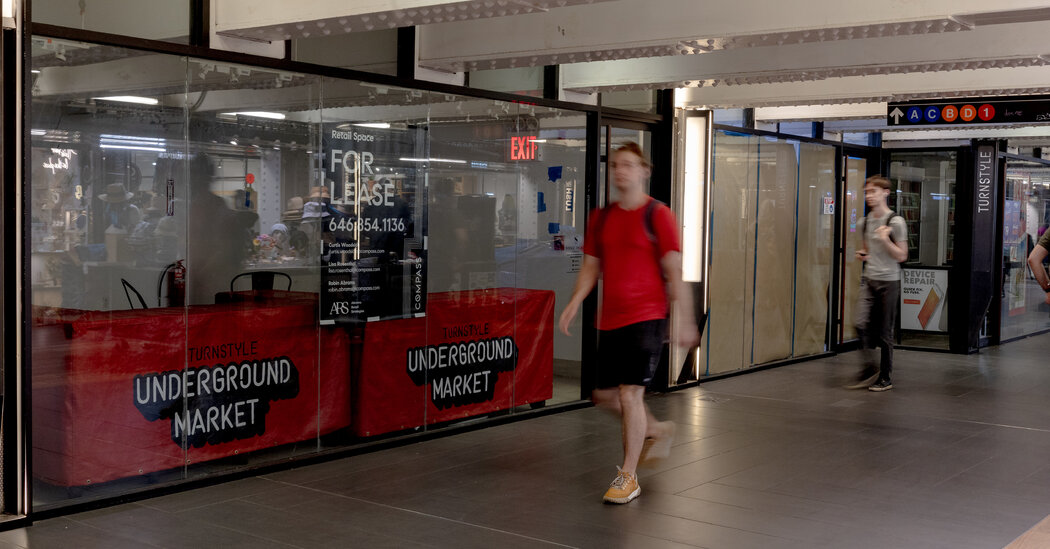Good morning. It’s Monday. Today we’ll look at the grim picture for businesses that operate in subway stations.
The state of retail in New York City’s vast underground subway system is, in a word, bleak.
At Columbus Circle, only one of the 40 shops that opened in its underground market eight years ago is still open. Fulton Center, a decade-old mall in a Lower Manhattan subway station, is nearly vacant. In Midtown, empty storefronts line the Port Authority and Rockefeller Center stations.
Nearly three-quarters of retail spaces in the transit network are empty, according to the Metropolitan Transportation Authority, a downward trend that began before the coronavirus pandemic but that was made worse by it and the rise of remote and hybrid work.
For riders, the empty storefronts have created a sense of unease and urban decay. Some doors have been locked with chains, their windows covered with for-lease signs. Homeless people have taken over empty corners of retail areas and sleep in stairwells.
Last year, roughly 3.6 million people rode the subway every weekday, a captive audience of potential shoppers to buy drinks and food as well as trinkets, gifts and clothing.
Subterranean retailers and newsstands once thrived and were nearly as ubiquitous as the subway cars themselves. Nedick’s served orange drinks and hot dogs. Tycoon Luncheonette slung coffee under Times Square 24 hours a day. Starting in 1904, the Grand Central Oyster Bar & Restaurant shucked oysters — and still does — inside Grand Central Terminal.
“It was phenomenal,” said Biana Todorovic, who was a co-owner of Tiecoon, a necktie and gift shop that closed during the pandemic after being open for two decades in Pennsylvania Station and for several years in Grand Central Terminal. “Each year we performed better than the year before, but I knew it would plateau at some point,” she said.
By the 1980s, there were roughly 350 stores, kiosks and concessions operated by the transit authority. But shopkeepers, especially those not selling food or drink, said that riders began to change their shopping habits over the past 10 to 15 years. People started to snap photos of items and say they would just order them on Amazon instead, they said.
Now, there are fewer people commuting to work every day. And of 195 retail spots, only 54 are open, the authority said.
For some of the owners, the empty spaces represent an unrealistic expectation of who was going to stop to shop while commuting.
“In the world of the New York City subway system, show me one person killing a lot of time,” said Marshal Cohen, a retail industry analyst at Circana, a market research firm. “Am I going to stop in the middle of my commute to try on a $200 pair of sunglasses?”
Louis Termini had thought people would stop for pizza.
Mr. Termini, who owns Ignazio’s, a pizzeria in the Dumbo area of Brooklyn, said he was persuaded to open a restaurant in the Columbus Circle station after being told that as many as 80,000 passengers might walk by every day.
He opened in 2018 at the opposite end of two marquee stores: a Starbucks and a Dylan’s Candy Bar, which were near the station’s turnstiles.
Both have since closed, as has Mr. Termini’s pizza shop, which lasted three months. He said he had lost $300,000 and had been so frustrated with the lack of business that he left behind everything, including the pizza ovens. Rent — about $13,000 a month, he said — had not been affordable, either.
“All the foot traffic went up the stairs and out of the station,” Mr. Termini said.
The authority collected nearly $53 million in retail revenue in 2023, down from $72 million in 2019, it said.
“We are trying to claw our way back,” said David Florio, the authority’s chief real estate transactions and operations officer.
Some retail owners still believe that there will be a turnaround. Evan Feldman opened a location of his doughnut shop, Doughnuttery, in Columbus Circle in 2018. It’s the only original shop still operating in the underground market there.
Mr. Feldman said that the transit authority had reduced his rent at the store, and that he had expanded his business by fulfilling catering orders to nearby office buildings and by accepting delivery orders online. The underground market is under new management, which has brought in additional security guards and removed homeless people from the stairwells.
“We are not going strong, but we still are making a go at it,” Mr. Feldman said. “We are a little resilient.”
Weather
Expect sunshine with temperatures in the low 90s. Tonight, it will be partly cloudy with temperatures in the low 70s.
ALTERNATE-SIDE PARKING
In effect until Aug. 13 (Tisha B’Av).
The latest New York news
Dear Diary:
While walking along a trail in Inwood Hill Park, I stopped to admire a rock formation helpfully labeled with a sign near the path that said: “Rock Formation.”
As I stood there, a bird watcher in full regalia paused next to me. Together, we stared at the rocks in silence.
“Would you like to borrow my binoculars?” the birder asked me.
“Sure,” I said. “What are we looking at?”
She pointed and traced her finger 40 feet up an enormous oak tree, stopping at a knot in the trunk before the branches split.
I put the binoculars to my eyes and looked up to where she was pointing. After a moment, I saw a small brown speck camouflaged in the bark staring back at me: a screech owl.
I brought the binoculars down and looked in the same spot. I never would have seen it, let alone noticed it, if she hadn’t stopped.
“Thank you for showing me,” I said.
“Of course,” she replied. “It’s always a pleasure to share the joys of the screech owl.”
— Nick Devor
Illustrated by Agnes Lee. Send submissions here and read more Metropolitan Diary here.
